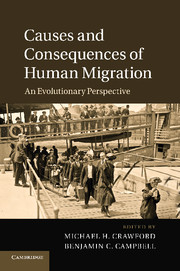Book contents
- Frontmatter
- Contents
- Contributors
- Preface
- 1 Perspectives on human migration: introduction
- Section 1 Theory
- Section 2 Geography and migration
- 8 Population structure and migration in Africa: correlations between archaeological, linguistic, and genetic data
- 9 Human migrations in North Africa
- 10 Identity, voice, community: new African immigrants to Kansas
- 11 The African colonial migration into Mexico: history and biological consequences
- 12 Demic expansion or cultural diffusion: migration and Basque origins
- 13 Consequences of migration among the Roma: immunoglobulin markers as a tool in investigating population relationships
- 14 Migration, assimilation, and admixture: genes of a Scot?
- 15 Mennonite migrations: genetic and demographic consequences
- 16 Human migratory history: through the looking-glass of genetic geography of Mycobacterium tuberculosis
- 17 Peopling the Tibetan plateau: migrants, genes, and genetic adaptations
- 18 Migration, globalization, instability, and Chinese in Peru
- 19 The great blue highway: human migration in the Pacific
- 20 Migration of pre-Hispanic and contemporary human Mexican populations
- 21 A review of the Tupi expansion in the Amazon
- 22 Molecular consequences of migration and urbanization in Peruvian Amazonia
- 23 Migration in Afro-Brazilian rural communities: crossing historical, demographic, and genetic data
- 24 Indentured migration, gene flow, and the formation of the Indo-Costa Rican population
- 25 Causes and consequences of migration to the Caribbean Islands and Central America: an evolutionary success story
- Section 3 Overview
- Index
- References
18 - Migration, globalization, instability, and Chinese in Peru
Published online by Cambridge University Press: 05 December 2012
- Frontmatter
- Contents
- Contributors
- Preface
- 1 Perspectives on human migration: introduction
- Section 1 Theory
- Section 2 Geography and migration
- 8 Population structure and migration in Africa: correlations between archaeological, linguistic, and genetic data
- 9 Human migrations in North Africa
- 10 Identity, voice, community: new African immigrants to Kansas
- 11 The African colonial migration into Mexico: history and biological consequences
- 12 Demic expansion or cultural diffusion: migration and Basque origins
- 13 Consequences of migration among the Roma: immunoglobulin markers as a tool in investigating population relationships
- 14 Migration, assimilation, and admixture: genes of a Scot?
- 15 Mennonite migrations: genetic and demographic consequences
- 16 Human migratory history: through the looking-glass of genetic geography of Mycobacterium tuberculosis
- 17 Peopling the Tibetan plateau: migrants, genes, and genetic adaptations
- 18 Migration, globalization, instability, and Chinese in Peru
- 19 The great blue highway: human migration in the Pacific
- 20 Migration of pre-Hispanic and contemporary human Mexican populations
- 21 A review of the Tupi expansion in the Amazon
- 22 Molecular consequences of migration and urbanization in Peruvian Amazonia
- 23 Migration in Afro-Brazilian rural communities: crossing historical, demographic, and genetic data
- 24 Indentured migration, gene flow, and the formation of the Indo-Costa Rican population
- 25 Causes and consequences of migration to the Caribbean Islands and Central America: an evolutionary success story
- Section 3 Overview
- Index
- References
Summary
Introduction
Tradition holds that Chinese were a non-migratory people with a strong ancestor-worshipping, homeland-bound culture. In the past, Chinese generally rarely left home without a compelling, pragmatic reason. They left home primarily to further their family name and fortune and thus honor their ancestors, such as taking the civil examinations and serving as esteemed scholar-bureaucrats, engaged in commerce activities, or seeking refuge in times of war or famine. Furthermore, those who did so most often expected to return – hopefully wealthier and/or with heightened social status – to die and be buried in the fold of family and ancestors (Purcell, 1965:30; Wang, 1966:23). As a Chinese proverb proclaims: Fallen leaves shall return to the roots, wanderers are to return to their place of birth. In Chinese history, imperial governments encouraged migration in the spirit of territorial expansionism only sporadically and typically discouraged or even outlawed migration to all foreign lands. This traditional Chinese migratory-adverse pattern was in distinct contrast to the German – and European – call in favor of crossing oceans as in: “Amerika Du hast es besser!” – America you have it better!
In the twenty-first century changes have been swift and dramatic. Not only has the People’s Republic of China – and Taiwan – made great strides in “catching up” with the West in general, and the United States specifically, but the Chinese are now leaving the Mainland and Taiwan in ever increasing numbers for overseas. In order to make sense of the twenty-first-century Chinese migratory dynamics it is first necessary to consider some fundamentals for international migration. In the twentieth century world populations underwent dramatic changes. The century began with some 1.6 billion and ended with some 6.1 billion (PRB Staff, 2004:3). Change was not just in numbers but, more importantly, in complexity, making the future not only more challenging but substantially more uncertain for ever greater numbers of individual human beings. Public discourse about population in general and divergent population shifts in particular grew more contentious. Whereas populations in the less developed world regions continued their unrelenting increases, those in the more developed areas experienced persistent decreases (see Figures 18.1 and 18.2).
- Type
- Chapter
- Information
- Causes and Consequences of Human MigrationAn Evolutionary Perspective, pp. 373 - 387Publisher: Cambridge University PressPrint publication year: 2012



